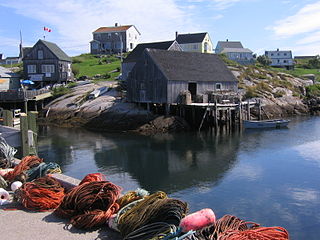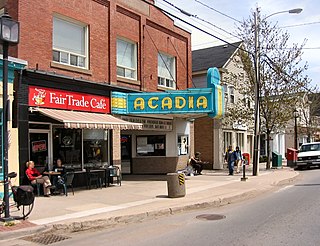
The Maritimes, also called the Maritime provinces or the Canadian Maritimes, is a region of Eastern Canada consisting of three provinces: New Brunswick, Nova Scotia, and Prince Edward Island (PEI). The Maritimes had a population of 1,813,606 in 2016. Together with Canada's easternmost province, Newfoundland and Labrador, the Maritime provinces make up the region of Atlantic Canada.

Wolfville is a Canadian town in the Annapolis Valley, Kings County, Nova Scotia, located about 100 kilometres (62 mi) northwest of the provincial capital, Halifax. The town is home to Acadia University and Landmark East School.

Acadia was a colony of New France in northeastern North America which included parts of eastern Quebec, the Maritime provinces, and Maine to the Kennebec River. During much of the 17th and early 18th centuries, Norridgewock on the Kennebec River and Castine at the end of the Penobscot River were the southernmost settlements of Acadia. The French government specified land bordering the Atlantic coast, roughly between the 40th and 46th parallels. It was eventually divided into British colonies. The population of Acadia included the various indigenous First Nations that comprised the Wabanaki Confederacy and descendants of French colonial settlers (Acadians). The two communities intermarried, which resulted in a significant portion of the population being Métis.

Westville is a town in Pictou County, Nova Scotia, Canada. It is located immediately west of Stellarton and about four kilometres southwest of New Glasgow, the major town in the area.

Port Royal is a Canadian rural community in Annapolis County, Nova Scotia.

Port-Royal National Historic Site is a National Historic Site located on the north bank of the Annapolis Basin in the community of Port Royal, Nova Scotia. The site is the location of the Habitation at Port-Royal.

Annapolis Royal, formerly known as Port Royal, is a town located in the western part of Annapolis County, Nova Scotia, Canada.
Acadia is the region of northeastern North America which was established as a French colony in the 17th century, today comprising roughly the Canadian provinces of Nova Scotia, New Brunswick, Prince Edward Island, the Gaspé region of Quebec; and parts of the U.S. state of Maine.

The Annapolis River is a Canadian river located in Nova Scotia's Annapolis Valley.

The New England Planters were settlers from the New England colonies who responded to invitations by the lieutenant governor of Nova Scotia, Charles Lawrence, to settle lands left vacant by the Bay of Fundy Campaign (1755) of the Acadian Expulsion.

The Acadians are the descendants of the French settlers, and sometimes the Indigenous peoples, of parts of Acadia in the northeastern region of North America comprising what is now the Canadian Maritime Provinces of New Brunswick, Nova Scotia, and Prince Edward Island, a Gaspé, in Quebec, and to the Kennebec River in southern Maine.

Nova Scotia is a Canadian province located in Canada's Maritimes. In known history, the oldest known residents of the province are the Mi'kmaq people. During the first 150 years of European settlement, the region was claimed by France and a colony formed, primarily made up of Catholic Acadians and Mi'kmaq. This time period involved six wars in which the Mi'kmaq along with the French and some Acadians resisted the British invasion of the region. During Father Le Loutre's War, the capital was moved from Annapolis Royal, Nova Scotia, to the newly established Halifax, Nova Scotia (1749). The warfare ended with the Burying the Hatchet ceremony (1761). After the colonial wars, New England Planters and Foreign Protestants immigrated to Nova Scotia. After the American Revolution, Loyalists immigrated to the colony. During the nineteenth century, Nova Scotia became self-governing in 1848 and joined the Canadian Confederation in 1867.
The Nova Scotia peninsula is a peninsula on the Atlantic coast of North America.

Acadia Broadcasting Limited is a commercial radio broadcasting company with its headquarters located on historic King Street in Saint John, New Brunswick, Canada. Its owner is Ocean Capital Investments, New Brunswick Limited. The focus is providing local radio for the communities it serves, live-to-air streaming on the internet, and podcasts. Acadia Broadcasting operates four radio stations in New Brunswick and two in Nova Scotia under the Acadia Broadcasting name. In 2007, Acadia Broadcasting acquired Fawcett Broadcasting with its three northwestern Ontario radio stations. In January 2010, Acadia acquired two more radio stations in Thunder Bay, Ontario. In March 2014, Acadia acquired a radio station in Moncton, New Brunswick. In April 2016, Acadia acquired a radio station in Yarmouth, Nova Scotia. In 2019, Acadia acquired a radio station in Port Hawkesbury, Nova Scotia.

Mount Denson is a small community in the Canadian province of Nova Scotia, located in The Municipality of the District of West Hants in Hants County. The community is named after Mount Denson; the mid-eighteenth-century estate of Henry Denny Denson.

The following outline is provided as an overview of and topical guide to Nova Scotia:
Grace Dean Rogers, née Grace Dean McLeod, was a Canadian novelist and historian.
The Halfway River is a tributary of the River Hebert in Nova Scotia, Canada.











